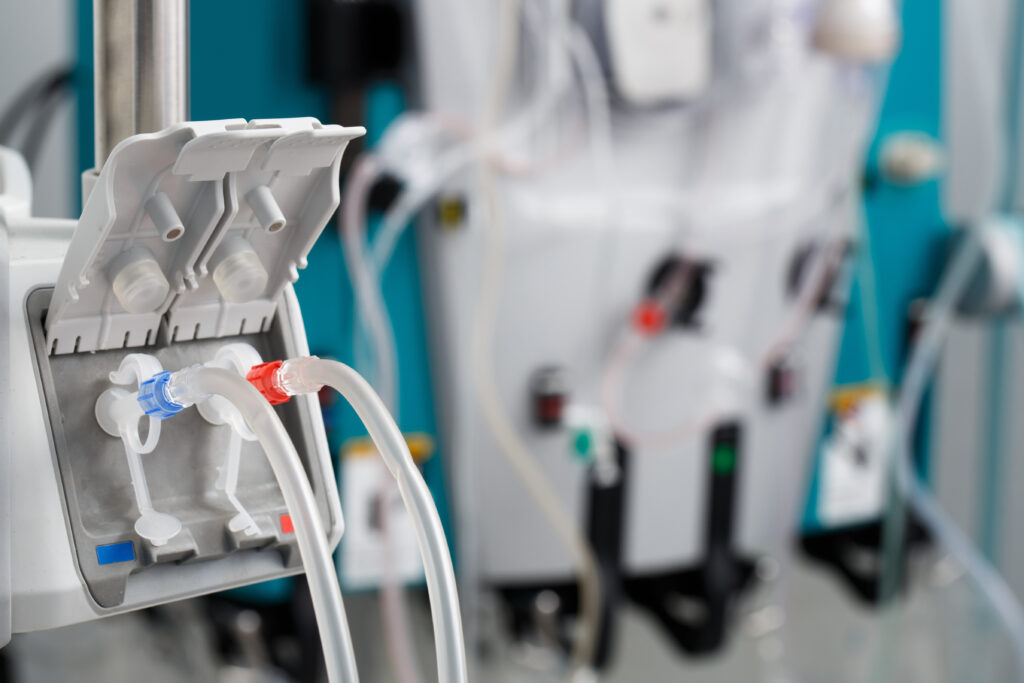Large dialysis chains charge Medicare Advantage plans 27% more for dialysis services compared with what they charge the traditional, fee-for-service Medicare program, according to a new USC analysis.
“The dialysis industry is heavily consolidated and two large national chains are the dominant provider in most communities,” said Eugene Lin, a clinical fellow at the USC Schaeffer Center and an assistant professor of nephrology at the Keck School of Medicine of USC. “As a result, these chains can wield their market power by forcing insurers to pay high prices. We’ve seen evidence of this in the commercial market, and now we are seeing the same thing in Medicare Advantage.”
The study, by researchers at the USC Schaeffer Center for Health Policy & Economics, appears in the August 2022 issue of Health Affairs. The researchers found:
- Two large providers dominate the dialysis market and use their leverage to negotiate Medicare Advantage payments that are significantly higher than what traditional Medicare pays.
- High markups could increase patients’ out-of-pocket spending and impact the financial viability of these plans.
- Researchers expect to see an increase in dialysis patients covered by Medicare Advantage. Prior to a change of rules in 2021, most dialysis patients were enrolled under traditional Medicare.
- Policymakers should address market consolidation among dialysis providers.
Medicare Advantage Poised to Have a Growing Segment of Dialysis Patients
Chronic kidney disease, when the kidneys have an impaired ability to filter toxins out of blood, affects more than 15% of U.S. adults. In the most advanced stages of the disease, patients must receive dialysis regularly or have a kidney transplant.
Historically, patients with kidney failure could receive coverage for dialysis through enrolling in traditional Medicare, regardless of age, but they were generally prohibited from enrolling in Medicare Advantage after initiating dialysis. The 21st Century Cures Act lifted those regulations prohibiting Medicare Advantage enrollment starting in 2021 and early reports indicate a significant shift towards these plans.
Sign up for Schaeffer Center news
Medicare Advantage plans are private health plans that beneficiaries can enroll in as an alternative to traditional Medicare. Enrollment in these plans has grown considerably in recent years because these plans tend to be easier for patients to navigate and often include more robust, additional benefits.
Prior to the regulatory change, patients who were already enrolled in a Medicare Advantage plan upon initiating dialysis were permitted to stay in that plan. Lin and his colleagues studied prices paid for dialysis services among these patients by analyzing data from three large insurers representing almost half of the Medicare Advantage market.
Compared with what traditional Medicare would have paid, Medicare Advantage plans paid 27% more for the median price of outpatient dialysis treatment.
“Our findings stand in sharp contrast to other areas we have previously studied—like physician services—where Medicare Advantage plans tend to pay providers rates that are very similar to traditional Medicare,” said Erin Trish, co-director of the USC Schaeffer Center and associate professor at the USC School of Pharmacy. “These high prices increase costs for Medicare Advantage plans and beneficiaries, especially as more patients receiving dialysis choose to enroll in Medicare Advantage.”
Large Dialysis Chains Supply Three-Quarters of all Dialysis Services in the U.S.
Over the last decade, the dialysis industry has consolidated considerably. Two large dialysis organizations supply more than three-quarters of all dialysis treatments in the U.S. More than a quarter of patients live in counties where one or both large dialysis organizations own all the facilities.
“In an interesting twist, providers can charge more in the Medicare Advantage market by being in network. If a patient goes to an out-of-network provider, the provider is prohibited from charging more than traditional Medicare,” said Erin Duffy, research scientist at the USC Schaeffer Center. “But when there are only one or two providers in a market, the insurance company loses any potential leverage to negotiate lower payments.”
Markups charged by large dialysis organizations were 31% higher than traditional Medicare. Markups to regional chains were 20% higher, markups to independently owned facilities were 12% higher and prices charged at hospital-based facilities were on par with Medicare rates. In contrast, out-of-network treatments at these facilities were on-par with what is paid to Medicare.
Though out-of-network dialysis treatments were cheaper for the plan, beneficiaries paid slightly more out-of-pocket and those with high spending paid quite a bit more annually.
Given that more patients on dialysis are expected to switch to a Medicare Advantage plan, this increase in dialysis spending may have downstream consequences including higher premiums or reduced benefits, write the authors. The researchers argue that policymakers should consider broad reforms to increase market competition.
Bich Ly of the USC Schaeffer Center also coauthored this paper. This research was supported by a grant from Arnold Ventures and the National Institute for Diabetes and Digestive and Kidney Diseases (NIDDK) (KO8 DK118213).
Related Work
-
Journal Articles
Payment for Dialysis Services in the Individual Market



